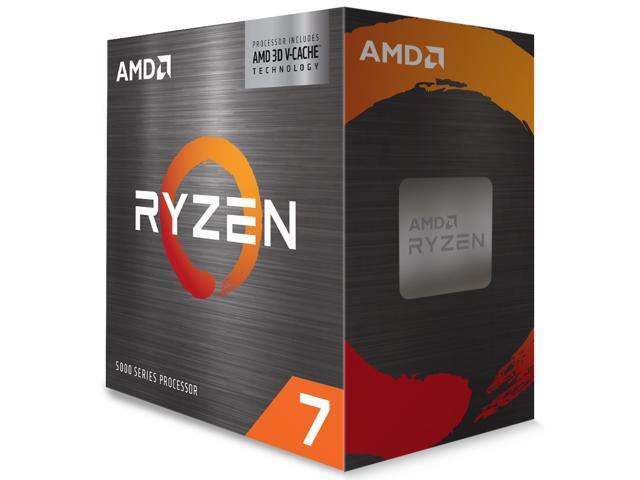Conclusion
In today’s performance comparison review, we compared the new AMD Ryzen 7 5800X3D versus the AMD Ryzen 7 5800X to find out how they differ in many different types of workloads. We tested synthetic benchmarks, rendering benchmarks, workstation benchmarks, and games, and looked at CPU clock frequency and power, and temperature.
The AMD Ryzen 7 5800X3D is a cool new CPU from AMD, proving that its 3D V-Cache Technology can work on a production CPU. It takes the already well-established Ryzen 7 5800X and adds triple the L3 Cache to bring it up to 96MB of L3 Cache. This is an amazing accomplishment, and AMD was able to pull it off while also not creating major latency bottlenecking issues.
The AMD Ryzen 7 5800X3D has an MSRP of $449, the same as the Ryzen 7 5800X, so it doesn’t cost you an arm or a leg of a premium, which is really nice. AMD has positioned this CPU as a gaming-oriented CPU, aimed at maintaining gaming performance dominance. However, it is just a stop-gap solution until Zen 4 comes out, which will truly harbor major improvements in IPC and frequency for gaming performance. Until then, the Ryzen 7 5800X3D is a great example that shows AMD’s technology works, it’s a point to everyone out there that AMD is innovating, and that it has some great new technologies up its sleeve to play with on future iterations and architectures.
The Ryzen 7 5800X3D, while it increases L3 Cache capacity, it doesn’t bring that improvement freely. It does have to sacrifice clock speed, and Voltage, in the realm of 200MHz versus the Ryzen 7 5800X, and overclocking ability. That means there are many applications that will actually be slower on the Ryzen 7 5800X3D. In our performance comparison today we found where the weak spots are for the Ryzen 7 5800X3D, and where its strengths are.
Synthetic and Rendering Performance
In our overall system testing, we started out with PCMark 10. In the standard benchmark, plus the Microsoft Office applications benchmark the Ryzen 7 5800X maintained the performance lead over the Ryzen 7 5800X3D by a few percent. The 5800X3D really offered no advantage. 3DMark’s CPU test continued to prove this, where its multi-threading performance was a few percent faster on the 5800X, and its single-threading performance was even greater, 7% faster on the 5800X. In Geekbench we saw the Ryzen 7 5800X3D come to the front, but only in multi-core, and only by a few percent. In single-core testing, the 5800X was faster by 5%. In PassMark, the CPUs were equal in performance.
When we looked closer at arithmetic and multimedia performance in multi-core and single-core testing in SiSoftware Sandra we saw these trends continue. The Ryzen 7 5800X was faster in all testing and had the biggest advantage in single-core testing where it could boost higher in terms of clock frequency.
When it came to rendering performance, in Cinebench and Blender, and V-Ray the Ryzen 7 5800X proved to be the fastest in every regard. The difference in Cinebench’s single-core testing of 7% for the 5800X was pretty significant. HandBrake showed no difference between the CPUs.
In SPECworkstation 3.1, doing heavy workstation workloads, the differences varied more here. There were finally many instances where the Ryzen 7 5800X3D was faster than the Ryzen 7 5800X, especially in Product Development and Life Sciences and Energy. The rest though, the Ryzen 7 5800X came out on top. Looking closely at the subsystem results performance was close between them, but there were a few specific applications that stood out on the Ryzen 7 5800X3D like WPCcfd, rodinioLifeSci, FFTW, srmp, and 7zip.
Gaming Performance
Gaming performance was also a mixed bag, just like productivity applications. Three of our games really showed no advantages with the Ryzen 7 5800X3D, while three other games did. It was half and half, which shows how game dependent the Ryzen 7 5800X3D’s advantages for gameplay performance really are.
In Dying Light 2, the Ryzen 7 5800X3D was literally under 1% for performance advantages, even at 1080p. The two CPUs performed nearly identical here. In Cyberpunk 2077 we saw a slight difference at 1080p, the 5800X3D was 4% faster, but only at 1080p. There were no performance differences at any resolution in Forza Horizon 5.
While those three games above showed no advantages, the next three games showed huge gains, especially Far Cry 6. In Far Cry 6 the Ryzen 7 5800X3D was 28% faster than the Ryzen 7 5800X, which is pretty massive considering the game is at “Ultra” settings with HD Textures. That performance advantage at 1080p fell off pretty quick at 1440p though, where it was only 8% faster than the Ryzen 7 5800X. At 4K performance was identical, no change.
Another game that seems to massively benefit from more L3 Cache is Flight Sim 2020, this game is heavily CPU bound, and the 5800X3D made a huge difference. This was also the only game where there was also an advantage at 4K. At 1080p the 5800X3D was 21% faster and at 1440p it was 24% faster and at 4K even 9% faster. This game was pretty surprising but can show in such a CPU-limited game how a CPU like the 5800X3D can really benefit it at all resolutions shockingly enough.
Another game that benefited from the 5800X3D was a game like Crysis Remastered, which is also known to be CPU bound. We saw an increase of 14% at 108op with the 5800X3D. However, that did drop off at 1440p and 4K.
Comparison Summary
When you look at the Ryzen 7 5800X3D as a whole, it does have some misses in several areas, mostly down to its lower clock frequency in comparison to the Ryzen 7 5800X. It’s also limited in its ability to utilize AMD Precision Boost Overdrive (PBO) or overclocking. We need to bring AMD PBO up because the AMD Ryzen 7 5800X fully supports PBO, while the Ryzen 7 5800X3D does not.
With AMD PBO you can turn this on in the BIOS or with Ryzen Software on the Ryzen 7 5800X. This can auto-overclock the Ryzen 7 5800X CPU by as much as 200MHz. When you take into consideration this overclock, we are now looking at a large 400MHz clock difference between the Ryzen 7 5800X and Ryzen 7 5800X3D. A Ryzen 7 5800X with PBO will improve its performance in everything, from applications to productivity, to rendering, to gaming. Whereas, the Ryzen 7 5800X3D really only has one claim to fame, potentially better gaming performance.
Even then, it is entirely game dependent on if that extra L3 Cache will actually provide a performance improvement in your game. We found that the game needs to be CPU dependent, to begin with, and or at a low resolution with a fast GPU. If you are playing games at a high resolution, like 4K, you are going to be GPU bound no matter what. If you aren’t running a GeForce RTX 3080 Ti or greater, then you are most likely also going to be always GPU bound at 1440p. That leaves only 1080p where it might benefit performance.
When it comes down to it, the AMD Ryzen 7 5800X is the better all-arounder CPU, as it provides better performance in everything you do with your PC beyond just gaming. If you want it to go faster, you can enable PBO and that will increase performance in everything non-gaming related, plus gaming related. That PBO increase will also help your gaming performance as the frequency is increased, perhaps even negating some of the impact of the 5800X3D’s extra L3 Cache.
Final Points
As it stands, the Ryzen 7 5800X3D is a great proof of concept CPU, it’s a phenomenal engineering feat and shows that AMD 3D V-Cache technology works well. The technology is pretty amazing and shows what we might expect more of in the future. AMD should get a round of applause for proving this technology works. We want to be hopeful that we will see 3D V-Cache again in future iterations of next-generation CPUs. Imagine a Zen 4 with 3D V-Cache, that’s something that really gets us excited.
The fact that the 5800X3D specifically has to run at a lower clock speed, and lower Voltage, and doesn’t support PBO or overclocking ultimately shows the current weakness that is inherent at this time. That overall does hinder it a bit except for specific cases.
Unless you want to try something uniquely cool out of curiosity, we’d suggest sticking with the regular Ryzen 7 5800X for all-around better performance, and a better value. Since the Ryzen 7 5800X has been out a while, its pricing is much more tolerable, it can be had for around $310 these days. That’s a $140 savings over the Ryzen 7 5800X3D right now.
With the Ryzen 7 5800X you can simply enable PBO in your BIOS which will improve performance in everything, from productivity to gaming. Attach good cooling to the 5800X, enable PBO, and you’ll enjoy improved performance beyond the 5800X3D in clock speed, by quite a wide margin, and with the prices as they are today, the 5800X is just the better deal.






